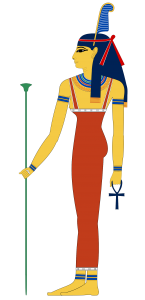It’s the first Friday of the month, and it’s time for a bit of Byron!
For preference, “The Destruction of Sennacherib” will always be my favorite of the poetic stylings of Mr. “mad, bad, and dangerous to know,” but “She Walks in Beauty” is gorgeous, too; a lovely example of the poetry of the Romantic era, and a personification of the Beauty that is Womanhood and all of that you learn in Sophomore English. As all Romantic poems do, it deals heavily in hyperbole and is a tiny bit on the ridiculous side, because I don’t know any women in whom all the best of anything meet anywhere, but your mileage may vary. When tasked to write in the style of Byron, I tried to gently capture that feel, going for the over-the-top flowery language and deathless symbolism while still writing something coherent (this may not have worked, but…). Instead of Beauty/Womanhood, I explored truth, via the story of Diogenes and Ma’at.

By Eric in SF – Own work, CC BY-SA 3.0, Link
Diogenes’s Daughters
Mere Beauty waits to take its bow
Beneath Cardinal Virtue’s gaze,
Seven, the Sisters make their vow
To Veritas, its arts to raise –
And to its Muse – her craft allow
To bright illuminate their days.Their clear gaze focused on the Truth
Seven set forth their Lamps to raise.
These, undeterred by age or youth
Eschewing private gain or praise,
Sought but to find, by means more couth
Knowledge to set the world ablaze.Astronomers’ celestial quest
Can no more match this thirst divine
‘Sapere aude!’ Know, and wrest,
From clamor’s call, an anodyne;
Against a world in sore distress –
One honest heart that’s genuine.
In college, there was a yearly competition to find these glorious early Spring flowers, called calochortus amibillis, commonly named Diogenes Lanterns. In the story, Diogenes walked about with a lit lamp because he was in search of one honest man. We never know if he found him, but he should have looked among the women, maybe…? Ma’at is old Egypt’s goddess of truth from which the personification of Justice as a woman holding a scale gets its basis. Though cuneiform tablets and old drawings do not depict her with a scale, her job was to weigh hearts and souls against the ostrich feather she wore in her hair. Only those souls lighter than her feather could go on to the afterlife.
Ma’at
She does her duty – what is right
In desert storms when high winds rise
When taloned carrion birds take flight
– and venturing out would be unwise.
When her gaze finds all clear and bright,
She still permits no compromise.Though deeds obscure, though lies oppress
The Scales she scries do not displace
A feather’s weight of faithfulness –
True hearts will show their truest face.
No matter if our hearts transgress,
An honest scale’s our saving grace.She walks ascendant, even now
Though clouds of lies disorient
Her staff in hand, her neck unbowed
Her feather weighs the soul’s intent.
So let it be: let us allow
This lightness, Love to represent.
Sapere aude is Latin for “dare to know.” Humanity has searched for and championed from antiquity various versions of The Truth. Do we dare to know? From myths and gods onward, the search continues…
Here’s Kelly, who started us off, telling us what that cousin really thinks. And Laura’s, which takes a decidedly glittery angle on things. In Sara’s, equine hoofbeats pound in iambic pentameter. Like most of us, Tricia found this challenge both fun and impossible to do while trying to do other things, and Liz skidded in at the finish line – with her usual grace. Andi continues to walk in beauty this month, and will catch us later. For more poetry, check out the Beyond Literacy Link blog.
BONUS ♦ BONUS ♦ BONUS ♦ ~ Next week, July 14th, is National Mac-and-Cheese Day. You know Poetry Friday Must Celebrate, right? Next week’s round-up is at Tabatha Yeats’ blog The Opposite of Indifference. Be there with cheese on – be it Gruyere or vegan cheddar.

A toast! To Veritas! To Ma’at! (…who seems a bit like Liz’s Mother Liberty, come to think of it…Perhaps the torch is as much feather as kettleball…)
@MaryLee: I love how much alike our poems turned out! I don’t quite know how that happened, but I ADORE that Lady Liberty poem, too!
You’ve written two beautiful poems here. These lines spoke to me:
Against a world in sore distress –
One honest heart that’s genuine.
True hearts will show their truest face.
No matter if our hearts transgress,
I love that you’ve tackled this theme. Perhaps even more, I always look forward to the writing around your poem–the history, the background, the story. You approach these challenges so thoughtfully. I take more of the Farragut approach, damning the torpedoes and all.
Do you know that you teach me every time we do this? For that, and so much more, I thank you.
@Tricia: You are lovely. I always think YOU do such a good job of telling us the heart and head behind what you came up with, and your facility with the form always makes me wonder what you’d have been like as an English teacher rather than Math!
You are a star for writing multiples of this poem! My favorite Byron may be these two stanzas from Childe Harold’s Pilgrimage: http://kellyrfineman.livejournal.com/551932.html
Now to figure out what to do about Mac & Cheese.
@Kelly: As soon as I said vegan cheese, I got a giggle… it is just not the stuff of poetry, alas!
Thank you for the reminder of that zinger of a Byron — that one is TRULY beautiful — the Sennacherib I just liked because I could rip it out with gusto plus moral authority (ahahahaha) as a child — but Childe Harold is truly beautiful.